Jennifer Van Horn
The bitter cold at Valley Forge, Pennsylvania, during the Continental Army’s winter encampment of 1777–1778 has become part of American mythology. That brutal chill, borne by George Washington and the soldiers whom he commanded in the American Revolution, was immortalized as bodily sacrifice for the cause of liberty, nowhere more compellingly than in artist William Trego’s painting March to Valley Forge (Fig. 1). In this late nineteenth-century history painting Trego placed vivid red strokes of paint to represent the soldiers’ tracks, bloody from “walking barefooted on the Ice or frozen Ground.”[1] His fictionalized representation glorifies the freezing temperatures endured by—in his re-envisioning—an all-white group of male soldiers.[2] Yet one intriguing object, a c.1790 plate warmer used at George Washington’s Virginia plantation Mount Vernon, as well as the president’s houses in New York and Philadelphia, affords a different perspective on Washington and the cold (Fig. 2).[3]
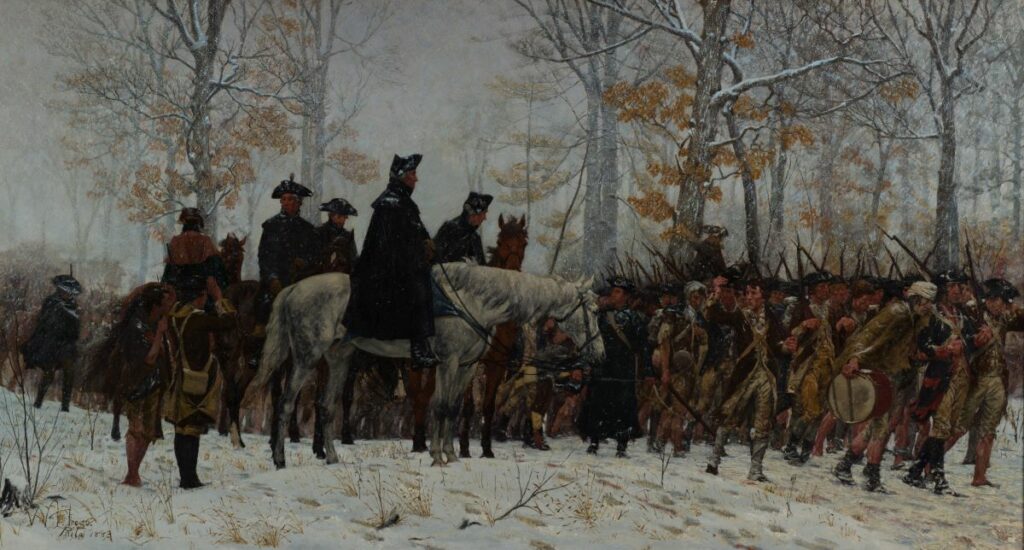
Produced in the United Kingdom and retailed in New York, the plate warmer is formed from sheets of tinned iron that were originally painted to increase their decorative appeal.[4] It was one of a pair that enslaved butler Frank Lee and enslaved waiters Cyrus, Austin, Christopher Sheels, and Marcus placed before the fireplaces in Washington’s dining spaces to prevent ceramic plates from chilling diners’ food.[5] While the Washingtons owned English creamware and Chinese export porcelain, the plates inside were often from the set of gilt-rimmed Sèvres porcelain that the Washingtons purchased about the same time (Fig. 3).[6] Together the warmers could accommodate the up to thirty-some guests who attended the Washingtons’ state dinners during the presidency and their formal dinners at Mount Vernon.[7] The plate warmers eliminated cold for white elite diners, but they posed the opposite problem for the enslaved Black butler and waiters who opened their doors and withdrew plates from the hot metal structures. For them, the plate warmers offered uncomfortable proximity to the fire and the radiant heat of what were, in effect, small stoves.
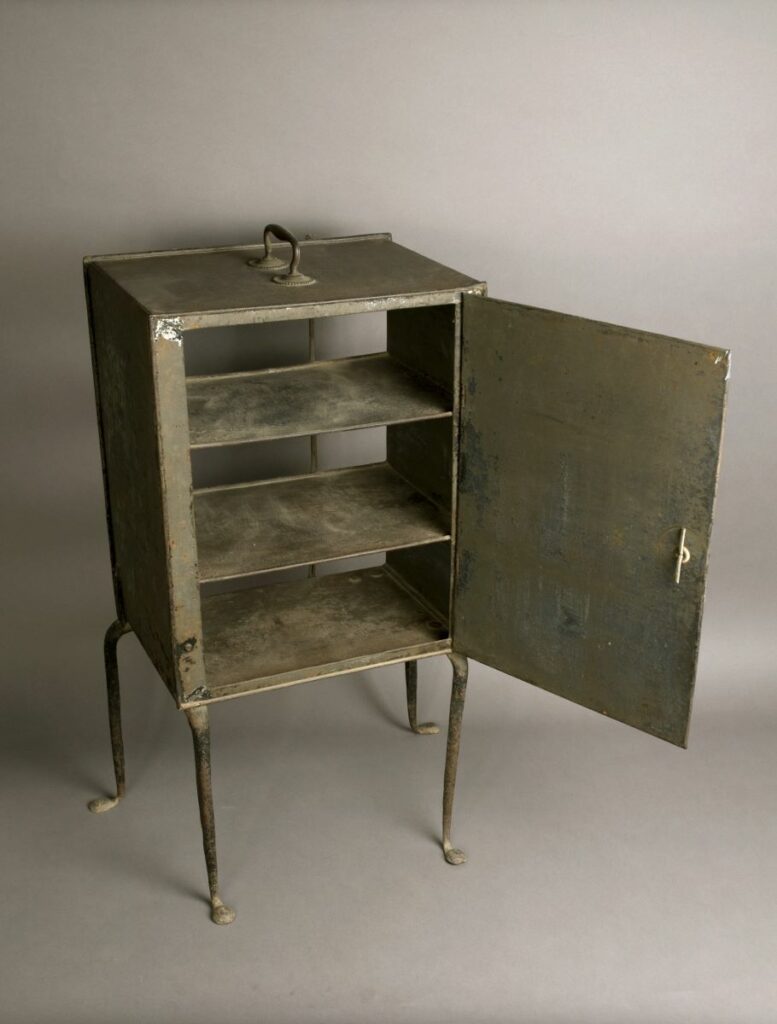
This essay uses the surviving Mount Vernon plate warmer to investigate the impact that George Washington’s attempts to eradicate cold had for many of the approximately 316 individuals of African origin and descent whom he enslaved, most significantly through enslaved domestic workers’ thermal labor. We often conceive of enslavement in relation to the extreme hot weather that enslaved laborers endured while cultivating staple crops. Yet historian Tony C. Perry’s important study of the impact of cold on enslaved people in Maryland demonstrates that cold too was a tool for enslavers’ brutalization as well as a means for enslaved persons to resist.[8] Drawing from sensory history as well material culture studies, this essay is indebted to vital scholarship in Black studies that has opened space to question the dynamic relationships between materiality, ecologies, anti-Black racism, and Black life.[9] Critical is the concept of thermoception, the sense by which living organisms feel temperature, which remains understudied, even within the new wealth of scholarship on the senses.[10] The plate warmer elucidates how racialized power structures infiltrated the lived and bodily experiences of both enslaved persons and their enslavers and provides a model for how other objects and spaces might be studied to further critical understandings of thermoception’s impact on formulations of race and the possibilities for insurgence it enabled. At Mount Vernon, the complex entanglements of cold, race, unfreedom, and materiality contributed to the creation of a racialized thermal order, one that enslaved persons resisted and subverted.

Washington’s Quest for Warmth
Heat and cold are fleeting bodily sensations, at once immediately apprehended and yet still historically determined. The Little Ice Age, which lasted from roughly 1300 to 1850 and was marked by a drop in average global temperatures, posed a significant challenge to attempts to keep warm in North America during the early republic. For instance, in February 1805 temperatures in mid-Atlantic cities such as Philadelphia averaged 26 degrees Fahrenheit (3.3 degrees Celsius), with at least three days below zero degrees (17.78 degrees Celsius).[11] Using a mercury thermometer that he purchased from New York instrument maker Joseph Gatty, Washington documented the chilly interior of Mount Vernon’s main house in the winter months. In his study on December 7, 1785, for instance, the “Thermometer [was] at 52 [degrees Fahrenheit] in the Morning & 59 at Noon” “but removing it … out of the room where the fire was, into the East Entry” a space with outside access, “the Mercury [dropped] to 42” degrees.[12] Mount Vernon’s dining spaces in the winter, therefore, were likely in the low to mid-fifties (10–13 degrees Celsius), a temperature range that New Englander John Innes Clark, writing in 1797, condemned as being “exceeding cold” for a dining room.[13]
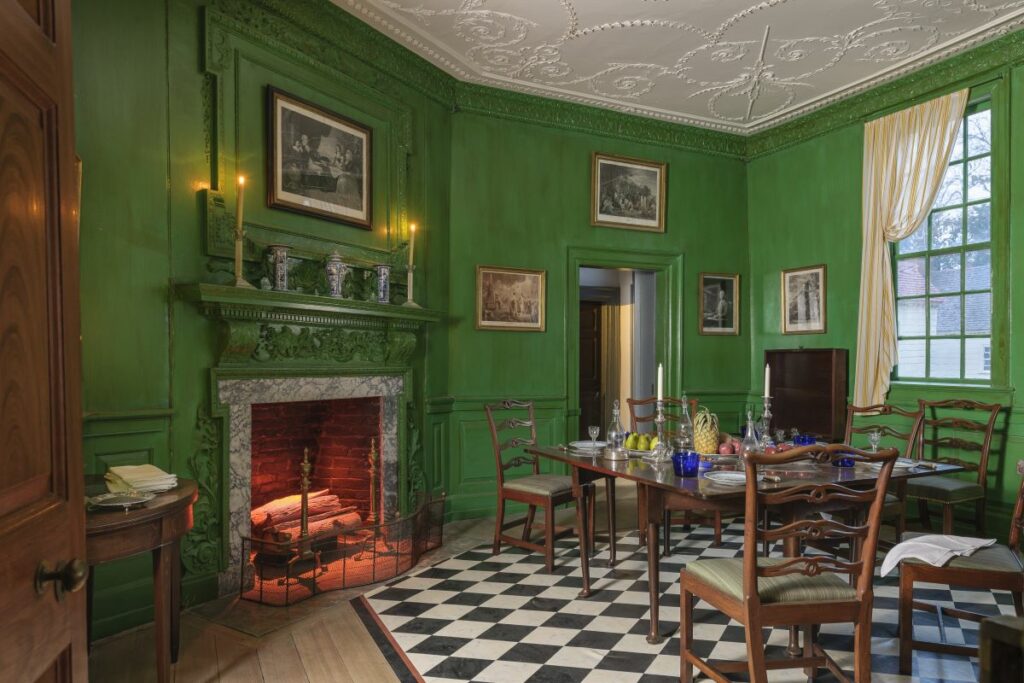
For food to reach Mount Vernon’s table, Frank Lee, Austin, Cyrus, Marcus, and Christopher Sheels carried it outside through even lower temperatures. They brought food from a separate kitchen building across an exterior colonnade and then into the dining room opposite Washington’s study (Fig. 4). Their route is suggested by a later nineteenth-century painting which includes a depiction of an unidentified enslaved woman walking from the kitchen to the main house along the colonnade bearing a laden tray (Fig. 5).[14] On special occasions enslaved waiters brought food even farther to diners in the New Room (Fig. 6). This vast two-story space, larger than the entire house of a middling Virginia plantation owner, did not lend itself to warmth; a “Venetian” (Palladian) window dominated the side wall (also an exterior wall of the house), with two exterior doors on either end of the room flanking the fireplace. More often used for dining in the summer, the Washingtons occasionally dined in the New Room in winter when the 52 degrees achieved in Washington’s smaller study would be aspirational.[15]
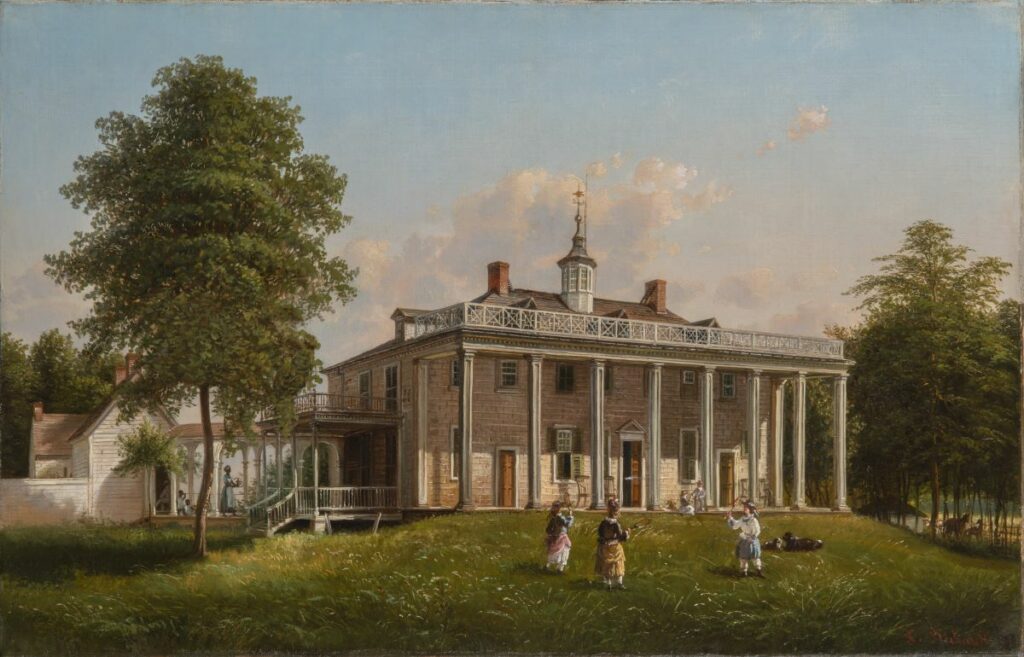
Given the cold temperatures, it is no surprise that earlier in the 1750s and 60s the Washingtons purchased several pewter and tinned iron hot water warmers for individual plates, perhaps used when someone was ill or eating in private.[16] By contrast, the Barry & Jones plate warmers were suited for larger social functions. While the reason for wanting heated plates might seem self-evident, we can situate Washington’s plate warmers within the emerging transatlantic idea of comfort embraced by elites in the second half of the eighteenth century that historian John Crowley has traced. To meet this demand, builders, architects, and designers attempted to increase heat efficiency by managing, channeling, and amplifying the combustion of wood, or what Benjamin Franklin called “our common Fewel.”[17] Placed in front of a fireplace in Washington’s dining spaces, the plate warmer participated in these efforts. Consisting of a cabinet formed from bent wrought iron, the plate warmer’s interior has two shelves to support stacks of plates which are buttressed by a pair of vertical iron rods in the back. The warmer created a micro-climate: when closed the door on the front kept the room’s colder air from reaching the plates within, while the open back enabled warmed air from the fire to circulate over them. That same radiant heat caused the metal to warm, thereby enhancing the fire’s impact on the porcelain placed inside. After a period of time, the plates’ temperature rose so that food placed on them would not chill immediately, increasing the desirability of the food diners ate by enriching its smell (which is easier to perceive when food is warm) and its taste.[18]
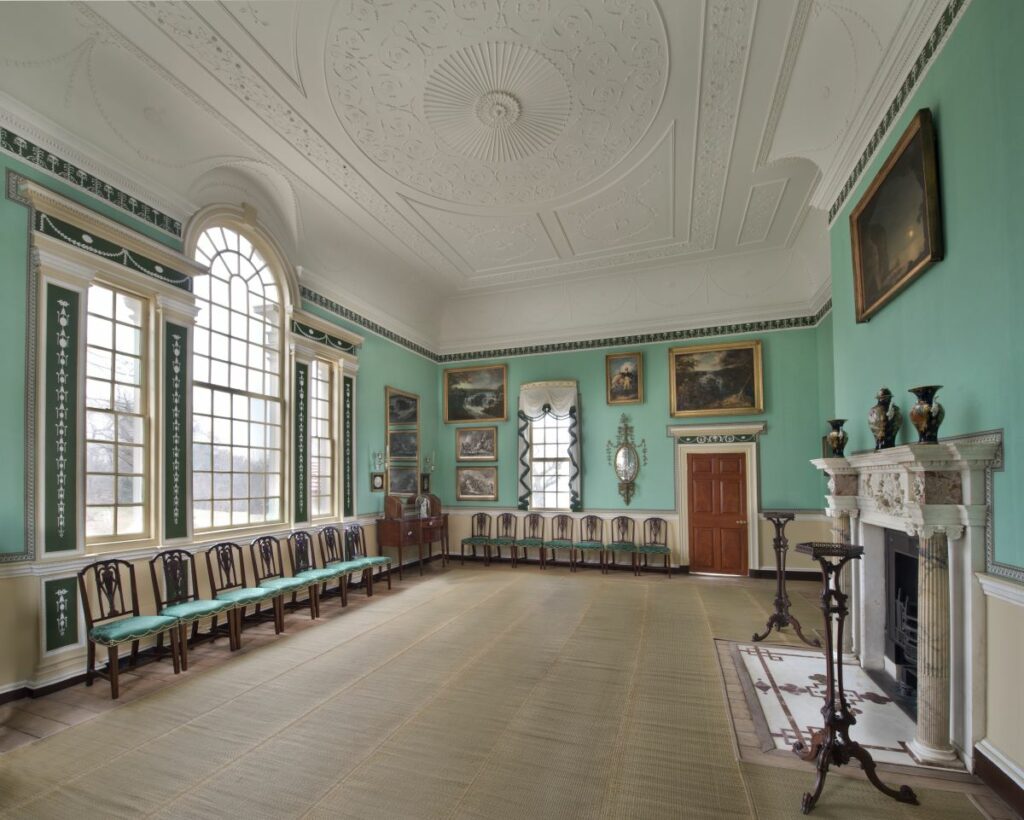
From the perspective of the enslaved Black waiters who did not enjoy the food on the plates they warmed, interacting with the plate warmer offered a different form of thermoception. To access the plates inside, Frank Lee, Austin, Marcus, Cyrus, and Christopher Sheels had to stand close to the fireplace and encounter more heat than was comfortable. By the 1830s, housework guides included directions for making chair screens that could attach to the back of a dining chair, and, as a later guide noted, “screen from the heat the backs of those persons who sit … next [to] the fire. Also, they will save the chairs from being scorched and blistered.”[19] Although no such screens survive from Mount Vernon, they suggest the fierce heat endured by those standing immediately before the fire. Indeed, the fire in the New Room’s fireplace was particularly hot, since after the presidency Washington had it fitted with a coal grate and steel surround that enhanced the fire’s radiated heat. (The rest of the fireplaces continued to burn wood.)[20] Mount Vernon’s enslaved waiters, then, had to navigate carefully, maintaining as much distance as possible from the flames while opening the plate warmer’s door and pulling the warmed plates from its metal interior. Brushing against the door, the frame, or the shelves could have burned the men. Added to that safety concern was the need to handle the Washingtons’ porcelain with care lest any plates break. Moreover, the enslaved waiters performed these motions under the watchful eyes of George and Martha Washington, their family, and guests. Diners’ laudatory comments about these enslaved waiters’ smooth efficiency are evidence of their prowess at this difficult material and thermal choreography. For example, New Jersey Reverend Ashbel Green, whom Washington invited to dine during the presidency, recollected: “Every servant knew what he was to do, and did it in the most quiet and yet rapid manner. The dishes and plate were removed and changed, with a silence and speed that seemed like enchantment.”[21]
Status Performance and Heat
While Washington sought warmth, he did not complete the labor required for it himself. Because the plate warmer had to be manipulated in order to function, its use in the dining room testified to Washington’s ability to displace thermal labor onto others. Simon Gikandi has argued for the fundamental connections between eighteenth-century performances of elite social standing and the institution of slavery. Placed in front of the elaborately carved fireplace in the dining room or the ornate marble fireplace in Mount Vernon’s New Room, the plate warmer became part of the Washingtons’ status display.[22] Given George Washington’s position as the first president of the United States, the plate warmer also contributed to his political reputation. The Washingtons’ dining display included the enslaved waiters whom Washington required to dress in livery that featured the family colors of scarlet and buff (red and white). One of these enslaved attendants, likely Christopher Sheels, is depicted in a circa 1795 representation of the Washington family painted by Edward Savage (Fig. 7). Standing behind the seated Washington family members, Sheels is positioned as he would have been in their dining room, ready to serve.[23] Sheels’s presence is a vivid reminder of George Washington’s public role as an enslaver: as President, he brought nine enslaved persons with him from Mount Vernon to New York and then Philadelphia, including Christopher Sheels, Austin, and Marcus. Washington also politically supported slavery during his presidency. This was most notable through the Fugitive Slave Act, which Washington signed into law in 1793. It enabled enslavers and their agents to track down freedom-seekers and made it illegal to aide a freedom-seeker.[24]

The original surface of the plate warmer would also have contributed to Washington’s status display. A tinned-iron plate warmer now in the collection of The Metropolitan Museum of Art, which is marbleized to recall stone, suggests the decorative painting that frequently adorned plate warmers manufactured in the United Kingdom and early United States (Fig. 8).[25] In the inventory of household goods made upon Washington’s retirement, the plate warmers are listed as “Japan-Ware,” suggesting that the black lacquer (portions of which remain) might once have been “japanned” or painted with a “chinoiserie” scene that mimicked Asian lacquer, as were many advertised for sale in the United States in the late eighteenth century.[26] On some plate warmers used in the southern states, makers also painted the cast iron handles to mimic brass or gold.[27] These faux-luxurious finishes rendered plate warmers’ utilitarian cast and tinned iron surfaces consonant with the well-appointed dining rooms around them and the expensive plates placed inside. An object designed to change plates’ temperature, thermal fluctuations nevertheless contributed to the deterioration of the Mount Vernon plate warmer’s “japanned” surface, resulting in scant traces of this original decoration. The process of repeated heating and cooling which caused the iron support to expand and contract encouraged the painted surface to pull away from the metal and eventually to crack and fall off.[28]
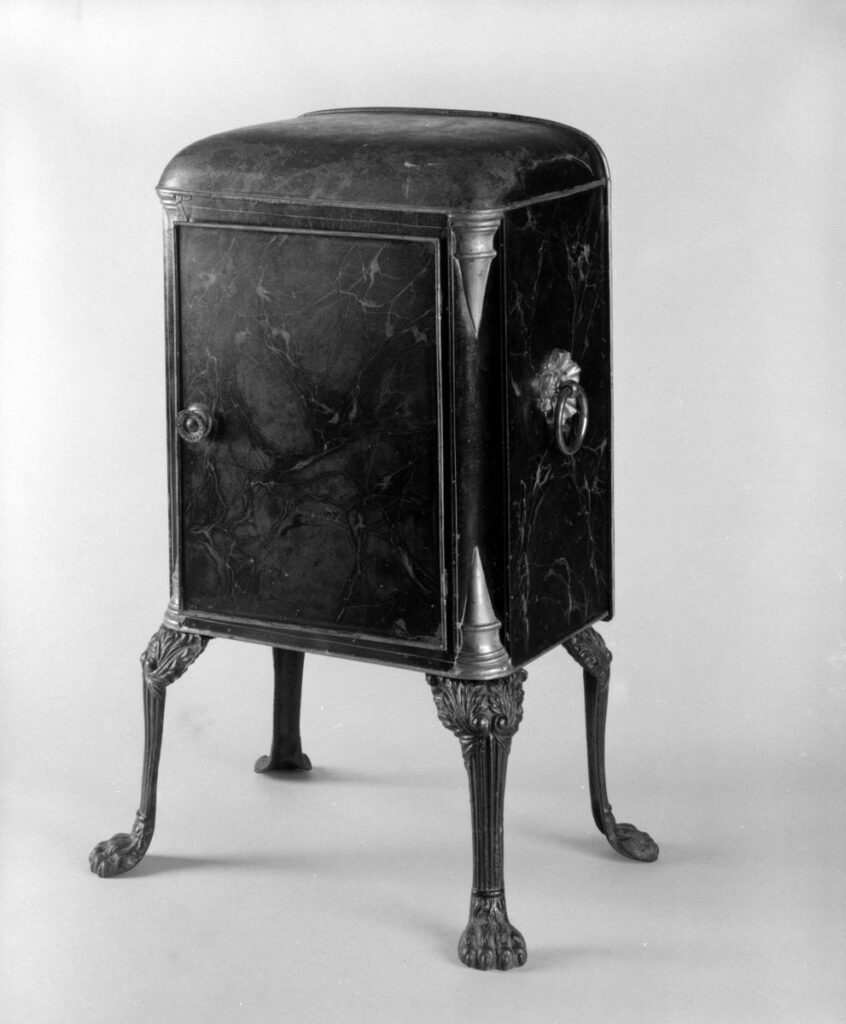
Active Thermoception
By highlighting the cumulative effect of thermal regulation on its materials, the plate warmer’s current degraded state illuminates warmth creation as an active process that required constant labor, labor that Washington demanded enslaved persons perform at Mount Vernon. At the president’s houses the Washingtons combined a labor force of enslaved persons and hired white domestic servants, and in later years at Mount Vernon they employed a white housekeeper.[29] Yet in the hierarchy of labor, fire maintenance fell to Black or enslaved domestic workers. These enslaved domestic workers’ interactions with the plate warmer can be best understood as part of their role as skilled thermal regulators at Washington’s plantation. Household heat produced by fire requires tremendous outlays of labor. Given Mount Vernon’s burgeoning number of rooms and fireplaces due to Washington’s extensive construction campaigns of the 1750s, 1770s, and 1780s, heating the main house necessitated increasing effort by enslaved butler Frank Lee and enslaved waiters Christopher Sheels, Austin, Cyrus, and Marcus, as well as enslaved housemaids Caroline Branham, Sall, Molly, and Charlotte.[30] Each morning between the arrival of fall and the late spring they brushed the main house’s hearths of ash and debris, polished and cleaned the andirons and fenders, stocked fires with wood and tended them throughout the day so that they produced a steady flame.[31] At nine or ten every evening enslaved domestic workers banked the fires in each fireplace to be sure that fire would not endanger the household overnight. That task likely fell to enslaved butler Frank Lee. Robert Roberts, a free African American butler who wrote a manual for domestic work published in 1828, enjoined: “This is the most important part of a servant’s duty, to see that the house, and all the fires are safe.” [32] Roberts’ reminder suggests the dangerous ramifications should fire maintenance not be performed accurately. Most of their work centered on creating and maintaining heat through Mount Vernon’s fireplaces, but enslaved domestic workers also managed heat away from the hearth, filling metal bed warmers with hot embers before placing them in the beds of the Washington family and their guests, as well as warming bricks for carriages.[33]
Prescriptive sources give insight into eighteenth- and nineteenth-century household thermal labor, but ethnographers focused on sustainability have further elucidated how the knowledge required to achieve a comfortable domestic temperature with fire can be understood as a form of active thermoception that differed significantly from the passive thermoception practiced by early modern elites and by many in western societies today. Sociologists Phillip Vannini and Jonathan Taggart argue that for heat producers in contemporary off-grid houses, thermoception is “a hub of activities” that respond to “wood heat[’s] … notoriously temperamental [nature], flaring up in bursts of tropical temperatures.” As they describe, practitioners become attuned to “the changing temperatures of their domestic surroundings, more aware of the affordances of their technologies, of local climate, and resources.”[34] Their analysis provides a frame of reference to recognize Mount Vernon’s enslaved domestic workers as skilled practitioners whose technical prowess and knowledge of materials enabled them to keep room temperatures constant despite ever-shifting conditions. Enslaved thermal regulators were adept at anticipating when to add more fuel and gauging how much was needed, recognizing when to adjust a log or fan the flames with bellows, and when to clear ash to best increase air flow. They knew which type of wood would last longest (in their region, the hardwoods of hickory, maple, and oak), which was best used as kindling (pine), and which would spark aggressively (gum). Enslaved domestic workers’ knowledge of wood’s material properties associated them with the crews of enslaved men who selected and cut trees and then chopped firewood from Washington’s land holdings for use at the main house [35] More broadly, enslaved people’s work throughout the early United States as extractors and processors of fossil fuels, whether cutting wood or mining iron ore, linked Blackness to resource extraction and enacted hierarchies of race and matter that supported a settler colonialist agenda, one that Washington advanced. A focus on thermoception reminds us that the domestic interior was a domestic ecology intimately connected with materials and actions that stretched beyond one moment in time or a single plantation.[36]
Despite the Washingtons’ thermal benefit, neither enslaved domestic workers’ expertise nor their daily tasks of heat management in the winter months registered in Washington’s writings. Although he noted the temperature inside Mount Vernon, he did not record the knowledge and effort required to maintain that heat. It is primarily through material objects, such as the plate warmer, that we can start to grasp enslaved domestic workers’ active thermoception. The probate inventory taken at Washington’s death lists the fireplace equipment that rested next to each fireplace, including the “Irons, Shovel & Tongs & Fender” located in the dining room.[37] Made of heat-resistant metals (iron or brass), these implements recall the plate warmer in materials, location, and conditions of use: all required careful manipulation of objects that conducted heat and necessitated a user’s proximity to fire. We can understand the plate warmer as a component of heating technologies that required enslaved users’ bodily discomfort in order to ensure the comfort of white elite bodies. Active thermoception is a series of actions and sensations that happened through compelled choreography with metal artifacts, but it cannot be reduced to them.[38]
Racialized Thermoception
In deploying enslaved persons for fire management, Washington relied on and perpetuated racist beliefs formed through global empire building that associated people of African origin and descent with heat. In the late eighteenth and early nineteenth centuries, European and white American ideas of racial difference predicated on white supremacy tied climate to skin tone and sensory perception. Racist natural historians and physicians maintained that the African continent’s tropical heat produced dark skin that they imagined to be better able to tolerate extreme temperatures. Thomas Jefferson, enslaver, president, and author, in his Notes on the State of Virginia (1785), claimed that African Americans were “more tolerant of heat…than…whites.” John Mitchell of Virginia, writing to London’s Royal Society in 1744, had similarly found Black skin to offer protection against heat, but in this case during contact with hot metal. He equated African Americans’ skin to that of “Smiths, &c. [those] constantly used to handle hot and hard Things,” maintaining that “the Skin of their Hands [has] become so thick and hard … as to be able in time to handle even hot Iron.”[39] Such racist ideas encouraged Washington and his white North American and British peers to conceive of Black bodies as less sensate and capable of enduring high temperatures without ill effects.
Some enslavers extended Black people’s supposed inability to be hurt by exposure to heat to the belief that enslaved persons could be exposed to cold without incident. Mitchell maintained that “a black Body retains more Heat than a white one,” and the same thickness of skin that white enslavers imagined protected enslaved people from heat would also supposedly ensure a measure of protection against chill. This falsehood had horrific consequences for those enslaved persons in North America whose enslavers denied them adequate clothing and shelter.[40] At Mount Vernon, the Polish visitor Julian Ursyn Niemcewicz decried the living conditions of agricultural workers and their children enslaved on the outlying farms of Washington’s plantation. Labeling their log dwellings “more miserable than the most miserable of the cottages of our peasants,” he noted “a very bad fireplace” before which “the husband and wife sleep on a mean pallet, the children on the ground.” While Washington described these enslaved persons as “warmly lodged … in houses of their own building,” Niemcewicz’s description suggests the fireplace’s inefficient heat for the space, especially when coupled with the gaps between logs filled only with daub.[41]
For white enslavers in the early republic, Black bodies could be deployed wherever their labor was required to keep white bodies temperate and their food pleasant—whether that be standing in the hot zone immediately before a fire and manipulating a plate warmer’s iron door, or laboring in the “freezing weather” to cut ice from the frozen Potomac River and pack it into Washington’s icehouse (four enslaved “Laborers at the Mansion House” undertook this frigid work on December 30, 1797). The ice that they harvested and packed in the ice house was then used by enslaved cooks Nathan, Lucy Lee, and Doll to make ice cream or cold beverages for the Washingtons and their guests in the summer when, as Martha Washington noted, “Ice is the most agreable [sic] thing we can have.”[42] While the plate warmer ensured food’s warmth for white diners in cold months, the ice cream enslaved waiters served in the Washingtons’ ice-topped Sèvres iceries (or glaciers) allowed white diners to experience a pleasurable chill in Virginia’s warmest months.[43]
Martha Washington’s words highlight the racialization of heat and cold at Mount Vernon. Thermoception affords a sensory register through which to better recover the plantation’s divided yet interlinking thermal landscapes, zones that sometimes intersected, as in dining spaces, but were always predicated on white bodies’ comfort. The plate warmer sits at the intersection of thermoception regimes: passive and active, elite and enslaved. As architectural historians Dell Upton and Rebecca Ginsburg have argued, the same physical sites on plantations could have vastly different meanings for enslavers and those persons they enslaved depending on the routes taken to reach them and the experiences, feelings, and forms of knowledge brought to them.[44] Recognizing thermoception as processional and affective—how someone reaches a specific thermal experience affects their perception of it—helps to illuminate the divergences in southern plantation spaces even within a shared space or around a shared object, such as a plate warmer.
The processional landscape experienced by white elite diners moved between relatively comfortable interior pockets heated moderately by fire, say from the parlor to the dining room, with the warmth of food at a meal offering a welcome olfactory sensation. Enslaved waiters, by contrast, moved between thermal extremes—the blazing warmth of the kitchen, the cold of the colonnaded passage, the unpleasant warmth near the fire of the New Room or the dining room. Moreover, their management of hot surfaces, both metal and porcelain, were components of their larger forced awareness of and attentiveness to hot energy. The active thermoception they practiced made their experience of heat and cold fundamentally different from the passive thermoception of white elites. By thinking about proximity and distance to heat and cold in spatial as well as material terms, we can recognize plantation dining spaces as oriented not simply around service to seated diners, but as a series of racialized thermoception zones.
Ensuring Temperate Plants
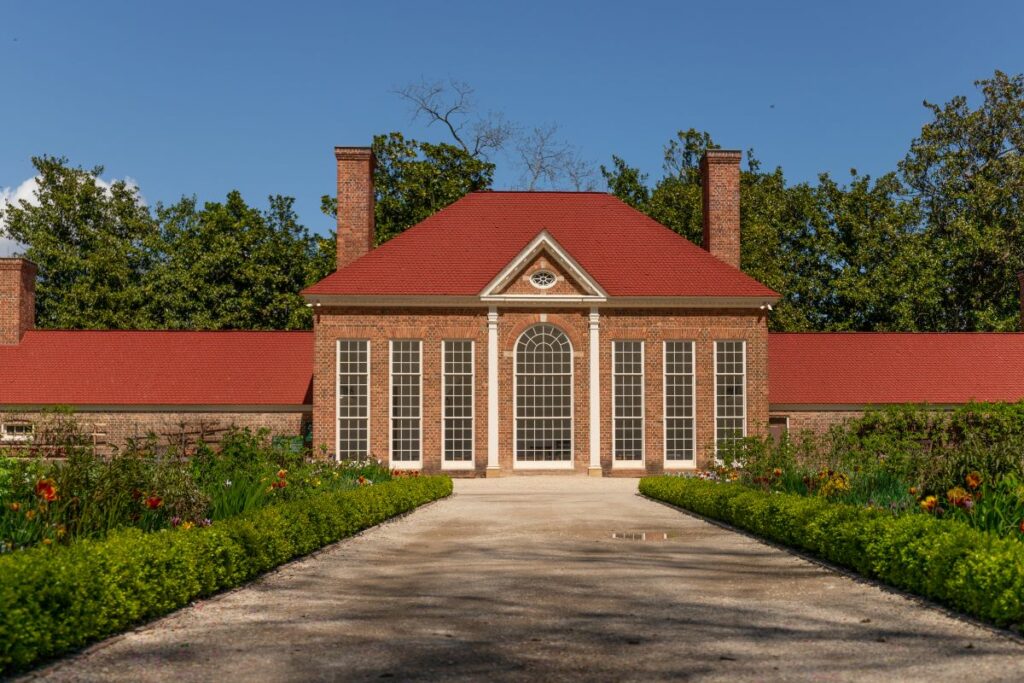
Taking the plate warmer as a starting point has encouraged us to think about cold and heat at the scale of a room with a single fireplace. But thermoception activates a transcalar thermal order, one visible beyond Mount Vernon’s main house in Washington’s greenhouse or orangerie. Enslaved masons and carpenters erected this brick structure in 1787 (Fig. 9). The greenhouse burned in the nineteenth century, and the Mount Vernon Ladies’ Association built a reconstruction on the foundation in 1951.[45] Like those constructed for Washington’s social peers in Maryland and Pennsylvania, his greenhouse enabled tropical plants, trees, and shrubs to grow “which will not live in these Northern Countries without artificial warmth in Winter,” as English gardener and botanist Phillip Miller described in his popular Gardener’s Dictionary (1754).[46] Together with the large south facing windows, Washington had a heating system installed to provide the warmth tropical plants needed to flourish.[47] This centered on a stove room constructed behind the greenhouse with a large fireplace from which warm air flowed through a series of flues and pipes underneath the floor to heat the plants (Fig. 10). That fire required an enslaved man or boy to sleep in the stove room to keep the flames continuously burning during the winter months. This labor was an extreme version of the thermal management undertaken in the main house.
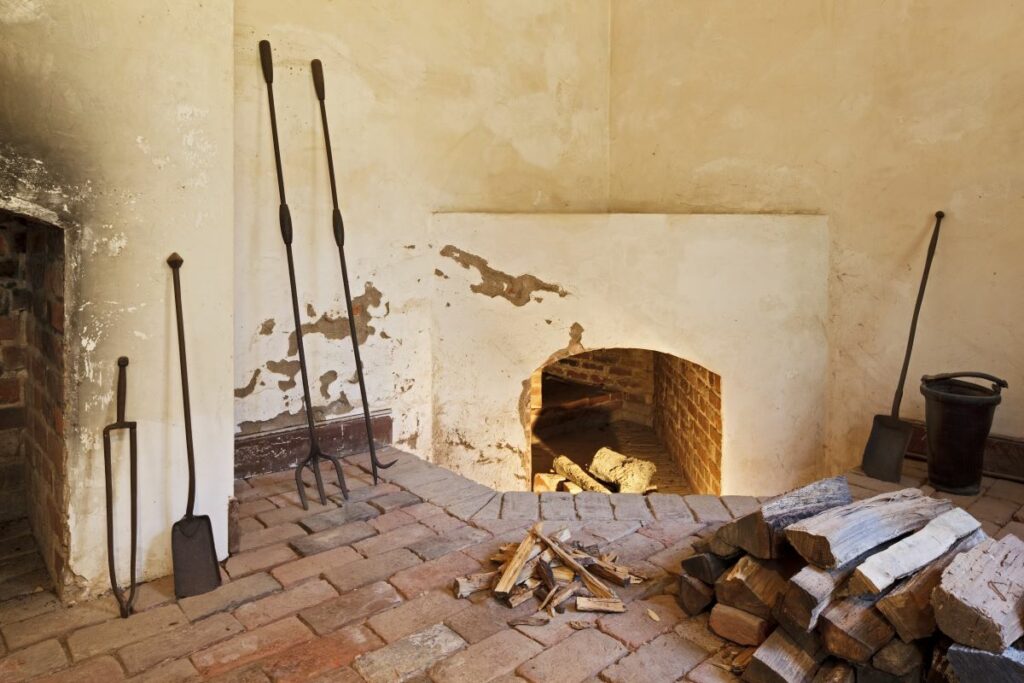
Washington’s thermal manipulation did not end there, however. Once he built the greenhouse, he reconceived of the housing for enslaved men and women who worked in the main house and the area adjacent. Washington’s preliminary plan shows the two symmetrical wings he had added to the greenhouse between 1791 and 1793, which consisted of four rooms for enslaved persons to live, two on each side (Fig. 11). These rooms, which housed 50 to 75 people altogether, offered little privacy for residents, who included the enslaved waiters and enslaved housemaids we have discussed (Fig. 12). Washington’s design was unusual: at this time, most plantation owners constructed individual dwelling places—oftentimes duplexes—like those that Washington himself had erected on his outlying farms.[48] With brick walls and a large fireplace in each room, the greenhouse quarters ensured warm temperatures for the enslaved residents who cooked meals and slept there, warmth that was perhaps welcome in the winter but uncomfortable in warmer months. To Washington, that warmth constituted a thermal solution for “preserving … tender Exotick Plants.” Phillip Miller enjoined readers planning to build greenhouses to consider adding rooms above and behind the plants “as being of great Use to keep the Frost out in very hard Winters.” In the greenhouse quarters enslaved people acted as a kind of living insulation, their body heat in this instance a passive form of heat creation. Even in sleep, they could help to warm Washington’s plants.[49]

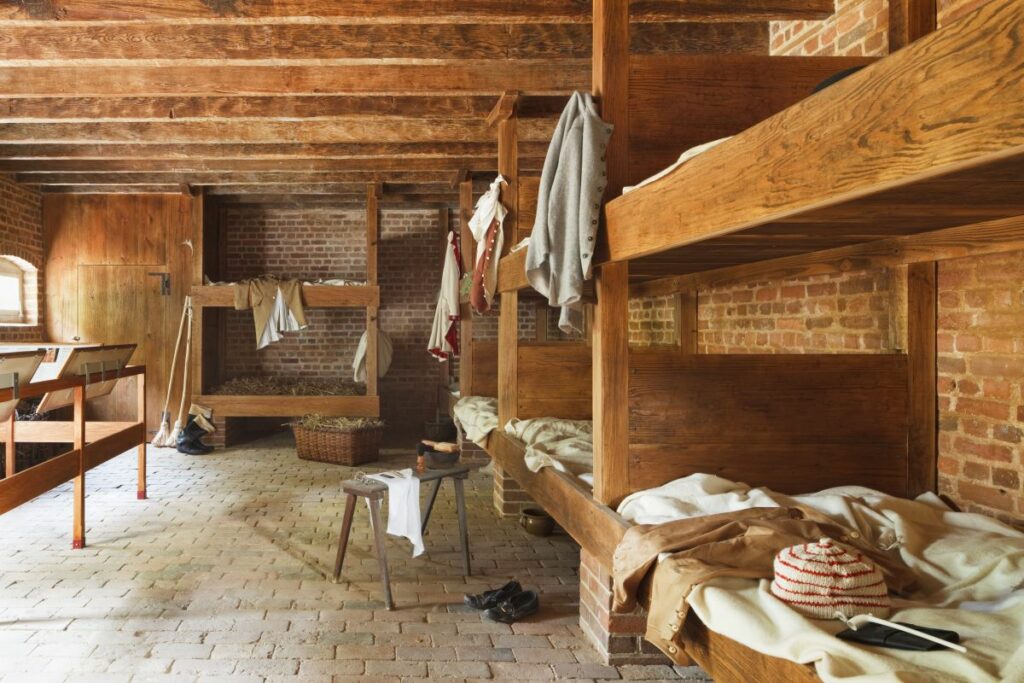
Thermoception and Emancipation
Returning to the mythologies of cold at Valley Forge with which this essay began, William Trego’s history painting and the plate warmer now appear to be part of an interrelated thermal order. The sacrifice that Trego glorified was of white bodies’ exposure to the cold—trauma that was made heroic by the assumption that white people deserved temperate conditions and therefore for white men to expose themselves to the cold willingly was virtuous sacrifice. Yet in the slaveholding republic of the early United States, enslaved people of African origin and descent bore heat and cold without recognition of their bodily discomfort by white enslavers.
When we move beyond privileging the sensory geographies of white elites to take seriously enslaved person’s active thermoception, we can then locate the subversive and potentially liberatory potential of the Black landscape or of insurgent geographies and geologies at plantations including Mount Vernon.[50] Tony C. Perry argues that cold in some instances facilitated resistance: many enslaved persons sought freedom in December, for example, despite the chill, counting on the snow to hide their scent from the dogs sent to track them and the decreased number of people traveling to lessen the possibility of detection.[51] Knowledge of heat management too was a tool for resistance: recognizing where spots of warmth would be on a given landscape, or what wood could produce the quickest and cleanest flame, facilitated self-emancipation. It is worth noting that two enslaved waiters attempted self-emancipation: Christopher Sheels, whose plan Washington discovered and foiled, and Marcus, who absconded successfully after Washington died.[52]
Heat’s liberatory potential emerged most clearly at Mount Vernon after Washington’s death. In his will Washington manumitted the 123 people whom he enslaved (as opposed to those who were part of the Custis estate which included Sheels and Marcus). Washington stipulated, however, that these enslaved persons not be manumitted until his wife’s death. After an attempt by unidentified enslaved persons to “set fire to Mount Vernon House,” the fear that they might do so again with greater success encouraged Martha Washington to manumit those who had been promised their freedom one year after Washington’s death. Those skills at thermal management that the Washingtons had relied on for comfort also provided a dangerous political weapon against them that enslaved persons leveraged for emancipation. Robert Roberts’ question, “How many instances have we heard and seen of houses being burnt through the neglect of the servants not having paid proper attention to the fires and lights?,” is a reminder of the power that enslaved thermal managers wielded.[53] So too is the later fire that destroyed the greenhouse. These revolutionary actions evoke fire as an insurgent force that disentangled active thermoception from comfort, enabling us to recognize thermal regulation as an arena for contestation.[54]
This essay has sought to identify the active thermoception practiced by enslaved persons at Mount Vernon while acknowledging that a commitment to unfreedom structured Washington’s enforced sensory geographies. That thermal order, moving from a plate warmer and dining room to a stove room and a greenhouse, also corresponded to the larger political and social structure of the early United States as a whole.[55] Under the leadership of Washington and his enslaving peers, the new republic codified enslaved people as property with a constitution that upheld enslavement and a fugitive slave law that sought to curtail Black peoples’ movement and opportunities for self-emancipation. Thermoception provides a means to begin to better understand the sensory dimensions of this racial contest for freedom in the early republic and beyond.
Jennifer Van Horn is Associate Professor of Art History and History at the University of Delaware and author of Portraits of Resistance: Activating Art During Slavery (New Haven: Yale University Press, 2022)
Acknowledgments: Thank you to issue editor Michael Yonan and Journal18 as well as the anonymous readers for their insights. Participants in the University of Delaware History Workshop, the Parsons/Cooper Hewitt Graduate Symposium, the Winterthur Academic Programs Research Fellowship Program, and the “World in a (Historic) House” series offered valuable feedback on versions of this essay. A NEH-postdoctoral fellowship at Winterthur Museum and Library (Spring 2022) made research and writing possible and George Washington’s Mount Vernon was generous with materials and images. Finally, thank you to Wendy Bellion, David Brody, Martin Brückner, Maggie Cao, Mónica Domínguez Torres, Nika Elder, Amy Freund, Jessica Horton, Jackie Killian, Louis Nelson, Catharine Dann Roeber, Hampton Smith, Ann Wagner, Sarah Wasserman, and as always Christian Koot.
[1] Wayne K. Bodle, The Valley Forge Winter: Civilians and Soldiers in War (University Park, PA: Pennsylvania State University Press, 2002). General William Alexander quoted in “Breaking Down Trego’s March to Valley Forge Painting,” November 19, 2019, Museum of the American Revolution Blog, https://www.amrevmuseum.org/learn-and-explore/collection/breaking-down-trego-march (all web links accessed September 17, 2023).
[2] African American men, enslaved and free, fought during the American Revolution. See Gary B. Nash, “The African Americans’ Revolution,” in Oxford Handbook of the American Revolution, ed. Edward G. Gray and Jane Kamensky (Oxford: Oxford University Press, 2012), 250–70.
[3] Catalogue entry “Plate warmer,” Mount Vernon Online Collections (hereafter MVOC), https://emuseum.mountvernon.org/collections.
[4] Washington purchased this plate warmer in 1790 during his first term as president from New York merchants Berry & Rogers. See “Plate Warmer,” MVOC; Helen Maggs Fede, Washington Furniture at Mount Vernon (Mount Vernon, VA: The Mount Vernon Ladies’ Association of the Union, 1966), 51–52. The fate of the missing plate warmer is unknown.
[5] Mary V. Thompson, “The Only Unavoidable Subject of Regret”: George Washington, Slavery, and the Enslaved Community at Mount Vernon (Charlottesville: University of Virginia Press, 2019). “Database of Mount Vernon’s Enslaved Community,” https://www.mountvernon.org/george-washington/slavery/slavery-database/; Digital Encyclopedia of George Washington (hereafter DEGW), George Washington’s Mount Vernon, https://www.mountvernon.org/library/digitalhistory/digital-encyclopedia/. I have included Austin because he was an enslaved waiter at Mount Vernon and used these plate warmers in New York City and Philadelphia. However, Austin died in 1794 during a return trip to Mount Vernon. See “Austin,” DEGW.
[6] Washington purchased a 300-piece set of Sèvres porcelain in New York in 1790 from the departing French minister, the Count de Moustier. Susan Gray Detweiller, George Washington’s Chinaware (New York: Harry N. Abrams, 1982).
[7] Dining With the Washingtons: Historic Recipes, Entertaining, and Hospitality from Mount Vernon, ed. Stephen A. McLeod (Chapel Hill: University of North Carolina Press for the Mount Vernon Ladies’ Association, 2011), 74–6; Carol Borchert Cadou, The George Washington Collection of Fine and Decorative Arts at Mount Vernon (Manchester, Vermont: Hudson Hills Press for the Mount Vernon Ladies Association, 2006).
[8] Tony C. Perry, “In Bondage When Cold Was King: The Frigid Terrain of Slavery in Antebellum Maryland,” Slavery & Abolition 38:1 (2017), 23-36.
[9] Katherine McKittrick, Demonic Grounds: Black Women and The Cartographies of Struggle (Minneapolis: University of Minnesota Press, 2006); Monique Allewaert, Ariel’s Ecology: Plantations, Personhood, and Colonialism in the American Tropics (Minneapolis: University of Minnesota Press, 2013); Kathryn Yusoff, A Billion Black Anthropocenes or None (Minneapolis: University of Minnesota Press, 2018); Tiffany Lethabo King, The Black Shoals: Offshore Formations of Black and Native Studies (Durham: Duke University Press, 2019); Justin Hosbey, Hilda Lloréns, and J.T. Roane, “Introduction: Global Black Ecologies,” Environment and Society 13:1 (September 2022), https://www.berghahnjournals.com/view/journals/environment-and-society/13/1/ares130101.xml.
[10] Boon Lay Ong, “Warming Up to Heat,” The Senses and Society 7:1 (2012): 5–21; Phillip Vannini and Jonathan Taggart, “Making Sense of Domestic Warmth: Affect, Involvement, and Thermoception in Off-grid Homes,” Body & Society 20:1 (2014): 61–84; Mark Paterson, “Haptic Geographies: Ethnography, Haptic Knowledges, and Sensuous Dispositions,” Progress in Human Geography 33:6 (2009): 766–788; and Hampton Smith & Zachariah DeGiulio, eds., Heat: Thresholds Fifty One (Boston: MIT Press, 2023). For the senses, see especially Constance Classen, Worlds of Sense: Exploring the Senses in History and Across Cultures (New York: Routledge, 1993), 122–38.
[11] Sam White, “The Real Little Ice Age,” The Journal of Interdisciplinary History 44:3 (Winter 2014): 237–52; Sean Patrick Adams, “Warming the Poor and Growing Consumers: Fuel Philanthropy in the Early Republic’s Urban North,” The Journal of American History 95:1 (June 2008), 69-94.
[12] George Washington Diary entries December 1785, Founders Online, (hereafter FO), https://founders.archives.gov; “The Weather Watch,” George Washington Papers, Library of Congress, https://www.loc.gov/collections/george-washington-papers/articles-and-essays/introduction-to-the-diaries-of-george-washington/the-weather-watch/. See also Susan Subak, The Five-Ton Life: Carbon, America, and the Culture That May Save Us (Lincoln: University of Nebraska Press, 2018), 32. I diverge from Subak in focusing on the labor and skill that heating Mount Vernon required.
[13] Innes’s dining room was “about 48 degrees [Fahrenheit].” John Innes Clark, December 21, 1797, quoted in Jane C. Nylander, Our Own Snug Fireside: Images of the New England Home, 1760-1860 (New Haven: Yale University Press, 1994), 75.
[14] McLeod, ed., Dining With the Washingtons, 51. The unidentified woman was enslaved by then Mount Vernon owner John Augustine Washington III.
[15] Joseph Manca, George Washington’s Eye: Landscape, Architecture, and Design at Mount Vernon (Baltimore: Johns Hopkins University Press, 2012), 14–55; Camille Wells, Material Witnesses: Domestic Architecture and Plantation Landscapes in Early Virginia (Charlottesville, VA: University of Virginia Press, 2018), 65–93; Susan P. Schoelwer, “How Did the Washingtons Use the New Room?,” https://www.mountvernon.org/the-estate-gardens/the-mansion/the-new-room/how-did-the-washingtons-use-the-new-room/.
[16] Catalogue entry “Hot water plate,” MVOC; Constantine Sidamon-Eristoff, Cynthia Volk, and Emma McClendon, “Warming Dish,” Dinner is Served, digital exhibition organized by the Bard Graduate Center, https://group2.commons.bgc.bard.edu/chafing-dish/#_ftnref1.
[17] John E. Crowley, The Invention of Comfort: Sensibilities & Design in Early Modern Britain & Early America (Baltimore, MD: Johns Hopkins University Press, 2001); Benjamin Franklin, An Account of the New Invented Pennsylvanian Fire-Places, November 15, 1744, FO.
[18] Ali Lara, “Affect, Heat and Tacos. A Speculative Account of Thermoception,” The Senses & Society 10:3 (2015): 275–97. Some period sources deride plate warmers’ efficacy, but consumers’ continued purchase and use testifies to their functionality. See Patricia Bixler Reber, “Plate Warmers,” Researching Food History blog, September 17, 2012, http://researchingfoodhistory.blogspot.com/2012/09/plate-warmers.html.
[19] Miss Leslie’s Lady’s Housebook; A Manual of Domestic Economy, 11th ed. (Philadelphia: A. Hart, 1850), 153–4; Patricia Bixler Reber, “Chair Screens,” Researching Food History blog, March 6, 2012, http://researchingfoodhistory.blogspot.com/2012/03/chair-screens.html.
[20] Adam Erby, “The Vaughan Mantle,” George Washington’s Mount Vernon, February 19, 2014, https://youtu.be/-yBeGJ44exQ; Subak, The Five-Ton Life, 27–31.
[21] Green quoted in McLeod, ed., Dining With the Washingtons, 28.
[22] Simon Gikandi, Slavery and the Culture of Taste (Princeton, NJ: Princeton University Press, 2011). For the fireplace and elite identity, see Mimi Hellman, “The Decorated Flame: Firedogs and the Tensions of the Hearth,” in Taking Shape: Finding Sculpture in the Decorative Arts (Los Angeles: Getty Publications, 2009), 176–85; and Matthew Craske, “Conversations and Chimneypieces: the Imagery of the Hearth in Eighteenth-Century English Family Portraiture,” British Art Studies, Issue 2, https://doi.org/10.17658/issn.2058-5462/issue-02/mcraske.
[23] For this possible identification of the Black figure, see Jennifer Van Horn, Portraits of Resistance: Activating Art During Slavery (New Haven: Yale University Press, 2022), 72–121.
[24] Erica Armstrong Dunbar, Never Caught: The Washingtons’ Relentless Pursuit of Their Runaway Slave Ona Judge (New York: Atria, 2017); Henry Wiencek, An Imperfect God: George Washington, His Slaves, and the Creation of America (New York: Farrar, Straus and Giroux, 2003); and Gary B. Nash, The Forgotten Fifth: African Americans in the Age of Revolution (Cambridge: Harvard University Press, 2006).
[25] Catalogue Entry “Plate warmer,” The Metropolitan Museum of Art Online Collections, https://www.metmuseum.org/art/collection/search/6496. For British-made and used “japanned” plate warmers see: Tredegar House, Newport, Wales, and Uppark House, Sussex, England, https://www.nationaltrustcollections.org.uk.
[26] George Washington, “Household furniture,” undated, Library of Congress George Washington Papers. See also Fede, Washington Furniture at Mount Vernon, 52. Survey of advertisements from Philadelphia, Boston, and New York using the Early American Newspapers database. For “japanning,” see Ethan W. Lasser, “Reading Japanned Furniture,” American Furniture (2007) https://chipstone.org/article.php/572/American-Furniture-2007/Reading-Japanned-Furniture.
[27] Plate Warmer CIS-2013-1111 and CIS-2017-0121, Decorative Arts of the Gulf South, https://louisianadigitallibrary.org/islandora/object/hnoc-p16313coll17:collection.
[28] Julie Gordon, Laura Normand, Anne Genachte-Le Bail, Sigrid Mirabaud et. al., “New Strategies for the Conservation of Paintings on Metal,” Proceedings of the Metal 2019 ICON-CC Metals Working Group Conference, 369–77.
[29] Edward Lawler, Jr., “The President’s House in Philadelphia,” https://www.ushistory.org/presidentshouse/history/index.php; Lindsay M. Chervinsky, “The Enslaved Household of President Washington,” The White House Historical Association https://www.whitehousehistory.org/the-enslaved-household-of-president-george-washington; “Eleanor Forbes,” DEGW.
[30] Vannini and Taggart, “Making Sense of Domestic Warmth,” 68; “Caroline Branham,” DEGW; “Growth of Mount Vernon,” DEGW.
[31] Nylander, Our Own Snug Fireside, 74–92; “Caroline Branham,” DEGW.
[32] Robert Roberts, The House Servant’s Directory… (New York: C.S. Francis, 1828), 67; Nylander, Our Own Snug Fireside, 88–92; George Washington Parke Custis, Recollections and Private Memoirs of Washington By His Adopted Son… ed., Benson J. Lossing (Philadelphia: J.W. Bradley, 1861), 493.
[33] Caroline Branham,” DEGW.
[34] Vannini and Taggart, “Making Sense of Domestic Warmth,” 63, 79.
[35] George Washington to James Anderson, November 1, 1798, FO. R.V. Reynolds and Albert H. Pierson, “Fuel Wood Used in the United States, 1630-1930,” Circular United States Department of Agriculture 641 (February 1942): 1–20.
[36] Erin J. Campbell, “Listening to Objects: an Ecological Approach to the Decorative Arts,” Journal of Art Historiography 11 (December 2014), 1–23; Yusoff, A Billion Black Anthropocenes or None.
[37] George Washington, Probate Inventory, December 14, 1799, Fairfax County, Virginia; “Probing the Past: Virginia and Maryland Probate Inventories, 1740-1810,” http://chnm.gmu.edu/probateinventory/index.php.
[38] Tim Ingold, Being Alive: Essays on Movement, Knowledge and Description (New York: Routledge, 2011). While I am focused on maintaining warmth, the punkah, an object that enslaved domestic workers used to combat white diners’ heat, invites comparison. See Dana E. Byrd, “Motive Power: Fans, Punkahs, and Fly Brushes in the Antebellum South,” Buildings & Landscapes: Journal of the Vernacular Architectural Form 23:1 (Spring 2016): 29–51. There was no punkah at Mount Vernon.
[39] Thomas Jefferson, “Laws” from Notes on the State of Virginia (1785), in The Portable Thomas Jefferson, ed. Merrill D. Peterson (New York: Viking Penguin, 1975), 139; Mark M. Smith, How Race Is Made: Slavery, Segregation, and the Senses (Chapel Hill: University of North Carolina Press, 2007), 11–28, quotation 17; Roxann Wheeler, The Complexion of Race: Categories of Difference in Eighteenth-Century British Culture (Philadelphia: University of Pennsylvania Press, 2000), 25–31.
[40] Mitchell quoted in Smith, How Race Is Made, 16-7. Tony C. Perry calls for recognition that enslavers utilized the environment to hurt enslaved people. This unquestionably happened. Yet the ideas of “scientists” also indicate willingness to deny Black suffering from cold, which accords with a larger process of attempted “dishumanization”. See Walter Johnson, River of Dark Dreams: Slavery and Empire in the Cotton Kingdom (Cambridge, MA: Harvard University Press, 2013), 187, 199, 207–8.
[41] Julian Ursyn Niemcewicz, Under Their Vine and Fig Tree: Travels through America in 1797-1799, 1805, with some further account of life in New Jersey, trans. and ed. Metchie J.E. Budka (Elizabeth, N.J.: Grassman Publishing Company, for The New Jersey Historical Society at Newark, 1965), 100; Dennis J. Pogue, “The Domestic Architecture of Slavery at George Washington’s Mount Vernon,” Winterthur Portfolio 37:1 (Spring 2002): 3–22, quotation 16. For Washington as an enslaver, see Wiencek, Imperfect God; Thompson, “The Only Unavoidable Subject of Regret”.
[42] “Ice, a Most Luxurious Crop,” George Washington’s Mount Vernon, https://www.mountvernon.org/the-estate-gardens/ice/, includes quotation from Martha Washington’s 1793 letter. For ice cream, see McLeod, ed., Dining With the Washingtons, 32–33; and Maggie M. Cao, “The Entropic History of Ice,” Ecologies, Agents, Terrains (Williamstown, MA: Sterling and Francine Clark Art Institute, 2018), 266–91. Cao establishes the relationship between ice consumption and colonialism, 282–3.
[43] Catalogue entry “Icery,” MVOC.
[44] Dell Upton, “Black and White Landscapes in Eighteenth-Century Virginia,” in Material Life in America 1600-1860, ed. Robert Blair St. George (Chicago: Northwestern University Press, 1988), 357–69; Rebecca Ginsburg, “Escaping through a Black Landscape,” Cabin, Quarter, Plantation: Architecture and Landscapes of North American Slavery, ed. Clifton Ellis and Rebecca Ginsburg (New Haven: Yale University Press, 2010), 51–66. See also Stephanie M. H. Camp, Closer to Freedom: Enslaved Women & Everyday Resistance in the Plantation South (Chapel Hill: University of North Carolina Press, 2004).
[45] “Greenhouse,” George Washington’s Mount Vernon, https://www.mountvernon.org/the-estate-gardens/location/greenhouse/.
[46]Philip Miller, Gardener’s Dictionary… (London: 1754), vol. 3, n.p. “ST”; M. Kent Brinkley, The Green Spring Plantation Greenhouse/Orangery And the Probable Evolution of the Domestic Area Landscape, Research Report, Colonial Williamsburg Foundation for Colonial National Historical Park, National Park Service (December 31, 2003), 117–32; Anne Yentsch, “The Calvert Orangerie in Annapolis, Maryland: A Horticultural Symbol of Power and Prestige,” in Earth Patterns: Essays in Landscape Archaeology, ed. William M. Kelso and Rachel Most (Charlottesville, VA: University Press of Virginia, 1990), 169–87.
[47] George Washington to Col. Tench Tilghman, August 11, 1784; Col. Tench Tilghman to George Washington, August 18, 1784, FO.
[48] Pogue, “The Domestic Architecture of Slavery at George Washington’s Mount Vernon.”
[49] Miller, Gardener’s Dictionary, vol. 2, n.p., “GR”.
[50] McKittrick, Demonic Grounds, 37–63; Yusoff, Billion Black Anthropocenes; King, The Black Shoals.
[51] Perry, “In Bondage When Cold Was King.”
[52]Thompson, “The Only Unavoidable Subject of Regret”, 282–3; Van Horn, Portraits of Resistance, 108-10; “Notice of Marcus,” The Philadelphia Gazette and Universal Daily Advertiser, May 30, 1800.
[53]For acts of arson at Mount Vernon, see Thompson, “The Only Unavoidable Subject of Regret”, 272–3, 311; Wiencek, Imperfect God, 35; Roberts, House Servant’s Directory, 67.
[54] Nigel Clark and Kathryn Yusoff, “Queer Fire,” Feminist Review 118 (April 2018): 7–24.
[55] Paterson, “Haptic Geographies,” 766-88. For a “thermal order,” see Classen, Worlds of Sense, 122–38.
Cite this article as: Jennifer Van Horn, “Racialized Thermoception: An Eighteenth-Century Plate Warmer,” Journal18, Issue 16 Cold (Fall 2023), https://www.journal18.org/6955.
Licence: CC BY-NC
Journal18 is published under a Creative Commons CC BY-NC International 4.0 license. Use of any content published in Journal18 must be for non-commercial purposes and appropriate credit must be given to the author of the content. Details for appropriate citation appear above.
